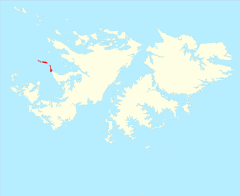Passage Islands: Difference between revisions
Created page with '{{Infobox island |name=Passage Islands |territory=Falkland Islands |map=Falkland Islands - The Passage Islands.svg |latitude=-51.592 |longitude=-60.724 }} The '''Passage Islands'…' |
mNo edit summary |
||
| Line 3: | Line 3: | ||
|territory=Falkland Islands | |territory=Falkland Islands | ||
|map=Falkland Islands - The Passage Islands.svg | |map=Falkland Islands - The Passage Islands.svg | ||
|map caption=Location of the Passage Islands (red) | |||
|latitude=-51.592 | |latitude=-51.592 | ||
|longitude=-60.724 | |longitude=-60.724 | ||
Revision as of 13:02, 27 September 2013
| Passage Islands | |
| Location | |
| Location: | 51°35’31"S, 60°43’26"W |
| Data | |
The Passage Islands are a group of four islands in the Falkland Islands, which stretch westward off Dunnose Head, West Falkland, at the mouth of King George Bay.
The main islands of the group are named, with singular efficient lack of imagination, First Island, Second Island, Third Island and Fourth Island.
Description
The largest of the group is Second Island which 5 miles long from east to west and up to a mile and a half wide. Much of the coastline is characterised by cliffs up to 100 feet. The highest point is Sixtus Hill. Past overgrazing has caused erosion and reduced the cover of tussac. There are several ponds, one of which provides feeding habitat for waders and waterfowl. Third and Fourth Islands are about 875 yards apart and low lying, rising to about 100 feet. They were only briefly stocked with cattle in the 1960s and have good tussac coverage.[1]
Important Bird Area
The Passage Islands group has been identified by BirdLife International as an "Important Bird Area". Birds for which the site is of conservation significance include Falkland Steamer Ducks, Gentoo Penguins (300 breeding pairs), Southern Rockhopper Penguins (145 pairs), Southern Giant Petrels, Striated Caracaras, White-bridled Finches, Blackish Cinclodes and Cobb's Wrens.[1]
References
- ↑ 1.0 1.1 "Passage Islands Group". Important Bird Areas factsheet. BirdLife International. 2012. http://www.birdlife.org. Retrieved 2012-10-16.
